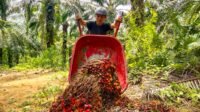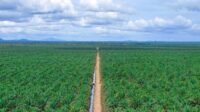PALMOILMAGAZINE, JAKARTA — Efforts to reduce carbon emissions are gaining momentum in the global palm oil sector. Even producing countries like Colombia have laid out strategies to cut greenhouse gas (GHG) emissions — a signal that the industry is not turning a blind eye to climate change issues.
Palm oil (Elaeis Guineensis Jacq) has long proven itself to be one of the most efficient vegetable oils, both in terms of yield per hectare and consistency of production. Its versatility makes it indispensable in modern industries: crude palm oil (CPO) is widely used in food products such as cooking oil and margarine, while non-food applications include candles, soap, cosmetics, and biodiesel. Byproducts from palm fruit, such as fiber, can also be processed into boards, pulp, renewable energy, and animal feed.
Global demand for palm oil continues to grow. Between 2015 and 2022, consumption rose by an average of 3.68% annually, dipping slightly in 2021–2022 due to pandemic-related lockdowns. However, in 2023 consumption rebounded sharply with a growth rate of 6.92%.
Also Read: GEBIE Secures BPJS Employment Protection for 1,000 Women Palm Oil Workers in South Sumatra
At the same time, the industry faces environmental scrutiny, particularly accusations of high carbon emissions. To address this, producing countries are stepping up strategies to reduce emissions from palm oil plantations and operations, aiming to counter these concerns and strengthen sustainability credentials.
On the global trade front, however, tracking the footprint of a commodity from upstream to downstream remains a major challenge. Charlotte Sedlock of the University of Michigan highlighted this issue during the International Conference on Palm Oil and Environment (ICOPE) 2025 in Bali.
According to Sedlock, transparency in supply chains is not only about formal policies but is also shaped by informal transactions that are often difficult to trace.
“Much more can be done — not always through formal measures, but also informally, depending on the type of commodity,” she explained during the session attended by Palmoilmagazine.com.
The biggest challenge, she noted, lies in gathering data from transactions that are not well documented, which makes it harder to clearly identify all actors involved in the supply chain. (P2)





































